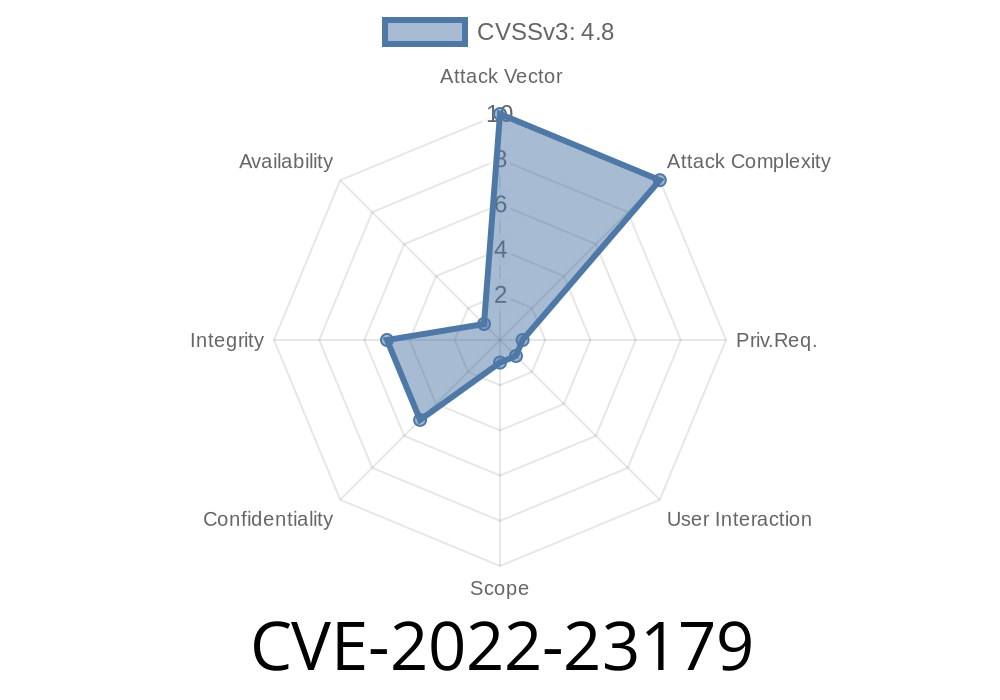If you use WordPress for your website and rely on popular form builders like Contact Form & Lead Form Elementor Builder, you might want to pay close attention to this story. In early 2022, a security researcher found a sneaky vulnerability—CVE-2022-23179—that could let hackers abuse trusted features and perform Cross-Site Scripting (XSS) attacks, even without having the usual high-level permissions. Let's break it down in simple terms so you know what happened, why it matters, and how attackers could exploit it.
What Is CVE-2022-23179?
CVE-2022-23179 is a vulnerability in the Contact Form & Lead Form Elementor Builder plugin for WordPress, up to version 1.7.. Here’s the core issue: some of the fields in these forms were being shown on the web page without being properly "escaped." That means any special characters typed into the fields—like HTML code or scripts—would be rendered directly in the HTML. If someone with high privileges (but not the ultimate “admin” level) used those fields in a certain way, they could inject JavaScript code that would run on the site. That’s a classic Cross-Site Scripting (XSS) attack.
Normally, WordPress tries to prevent these attacks by removing dangerous code, unless a user has the special *unfiltered_html* ability. But this plugin didn't apply those protections everywhere, so it accidentally opened the door—even where it shouldn't.
Sites using Elementor Lead Form plugin (versions < 1.7.)
- High privilege users (like Editors or Custom Roles) who do NOT have unfiltered_html, but can access Elementor
Visitors, if an XSS payload is injected
Attackers would still need a pretty strong user role (not just a subscriber or guest), but remember: not all editors and site maintainers are security-savvy—and sometimes attackers gain access to these accounts through phishing or weak passwords.
How Does the Attack Work? (Step by Step)
When a privileged user creates or updates a form with the plugin, they can set various options like the field label, description, button text, etc. The plugin did not escape these user-supplied settings before putting them into HTML attributes on the front-end.
Suppose the plugin outputs something like this
<input type="text" name="lead_name" placeholder="<?php echo $field_placeholder; ?>">
If $field_placeholder contains something like
Hey" onfocus="alert('XSS')
The generated HTML becomes
<input type="text" name="lead_name" placeholder="Hey" onfocus="alert('XSS')">
Now, whenever a user focuses on the field, that JavaScript executes—classic XSS!
Save or update the form.
4. Visit the published page with the form: the attack will trigger as soon as someone interacts with the input field.
Try this (only on testing systems!)
test" autofocus onfocus="alert('CVE-2022-23179 XSS')"
How Was It Fixed?
The plugin authors patched the issue by adding proper escaping to all user-supplied values before outputting them to HTML attributes. This means special HTML characters—like double quotes, angle brackets, and ampersands—are now safely converted to harmless codes.
You can see their changelog here:
> *Security update: Fixed XSS vulnerability by properly escaping outputs.*
Best Practices: How To Stay Safe
1. Update Your Plugins! Always run the latest version of any plugin, especially contact forms or anything that collects user data.
Official References and More Reading
- NVD Entry: CVE-2022-23179
- WPScan Advisory
- Plugin Page
- Elementor Official Website
Conclusion
CVE-2022-23179 is a classic lesson on why security hygiene matters at every step—even for site editors and “safe” settings screens. Just because a plugin is popular and open to trusted users, doesn’t mean it can’t go wrong! If you ever use forms through Elementor Lead Form, double-check you’re running at least version 1.7., and share this with your site administrators.
Timeline
Published on: 01/16/2024 16:15:09 UTC
Last modified on: 01/23/2024 20:42:27 UTC
